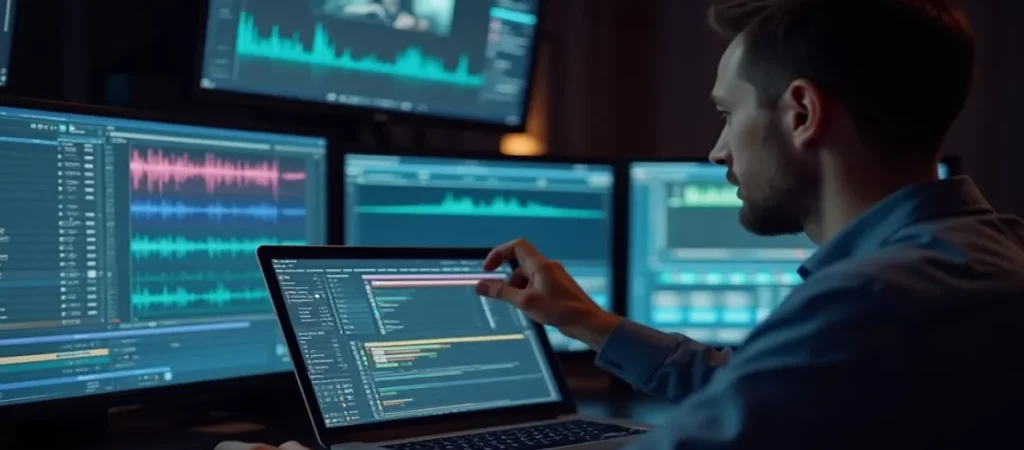In the fast-paced world of broadcasting, efficiency isn’t just an advantage—it’s a necessity. The demand for real-time information delivery, coupled with the need for accessibility and compliance, puts immense pressure on broadcasters to streamline their workflows. One of the critical components in broadcasting is the effective use of transcription and captioning. These elements are not only essential for creating a comprehensive viewer experience but also for meeting regulatory standards.
Automated transcription and captioning solutions have emerged as game-changers, offering numerous advantages over traditional, manual methods. By leveraging automated transcription and captioning, broadcasters can optimize their workflows.
The Role of Transcription in Broadcasting
Importance of Accurate Transcriptions for Broadcast Content
Transcriptions serve as a textual representation of audio content, making it accessible and searchable. Accurate transcriptions are vital for several reasons:
- Content Creation and Repurposing: Transcriptions enable broadcasters to repurpose content for different formats. For example, a transcribed interview can be turned into an article, blog post, or social media content.
- Audience Trust and Engagement: Audiences are likelier to trust and engage with accurately transcribed content. Trust is essential for building and maintaining a loyal audience base.
- Content Indexing: Enhances search engine optimization (SEO) and makes content discoverable.
Challenges of Manual Transcription Processes
Manual transcription, the traditional method of converting spoken words into written text, presents several significant challenges that can impede the efficiency of broadcasting operations.
- Labor-Intensive: Manual transcription requires considerable human effort. Transcribers must listen to audio or video recordings, often replaying sections multiple times to ensure accuracy. This meticulous process can be physically and mentally exhausting, leading to fatigue and potential errors.
- Time-consuming: Manual transcription is inherently slow. Depending on the complexity and length of the content, it can take several hours to transcribe even a short segment accurately. This time-consuming nature can cause bottlenecks in production schedules, delaying the content release and hindering the overall workflow.
- Susceptibility to Human Error: Human transcribers are prone to mistakes regardless of skill level. These errors can stem from mishearing words, especially in poor audio quality, accents, or overlapping speech. Such inaccuracies can result in inconsistent and unreliable transcripts, affecting the quality of the content delivered to the audience.
- Inconsistency: Different transcribers may interpret and transcribe audio content in various ways, leading to inconsistent transcripts. This variability can be problematic, especially when accuracy and uniformity are critical, such as in legal or regulatory contexts.
- Increased Operational Costs: Employing skilled transcribers is costly. Labor costs can quickly escalate due to the extensive time required to produce accurate transcripts. Additionally, the need for multiple transcribers to handle high volumes of content can further increase expenses, straining the operational budget.
- Delays in Content Delivery: The slow pace of manual transcription can lead to significant delays in making content available to viewers. In the fast-paced broadcasting environment, these delays can be detrimental, preventing the timely dissemination of news and information.
- Difficulty in Handling Large Volumes of Content: As broadcast content volume grows, manual transcription becomes increasingly impractical. Handling large volumes of content efficiently is beyond the capacity of human transcribers, leading to backlogs and further delays.
- Maintaining Quality Control: Ensuring consistent quality across manually produced transcripts is challenging. Regular quality checks and revisions are necessary, adding to the time and cost burden.
How Automation Streamlines Transcription Tasks
Automated transcription technologies leverage advanced algorithms to convert speech into text quickly and accurately. The benefits include:
- Speed: Transcripts can be generated in real-time or near-real-time.
- Cost-Effectiveness: Reduces the need for extensive human resources.
- Consistency: Delivers uniform quality across different pieces of content.
TranceIQ: New Age Solution to Automated Transcript Generation
In today’s fast-paced media environment, efficiency and precision are essential. The faster you switch to an automated solution, the faster you can scale your broadcasting business and boost efficiency. TranceIQ by Digital Nirvana is the game-changer for automated transcription and captioning, transforming media workflows. By leveraging advanced AI, TranceIQ allows you to:
Streamline Operations: Speed up production cycles with automated transcription and captioning.
Boost Accuracy: Utilize AI-driven precision to minimize manual errors.
Enhance Accessibility: Create inclusive content with reliable subtitles and captions.
Integrate Seamlessly: Fit TranceIQ effortlessly into your current workflow.
Learn how to integrate automated transcription and captioning into your broadcasting business. Schedule a demo and see TranceIQ in action!
Enhancing Captioning Processes with Automation
The Critical Role of Captioning in Accessibility and Compliance
Captions are crucial in making broadcast content accessible to a broader audience, particularly those who are deaf or hard of hearing. They provide a textual representation of spoken words and essential audio cues, ensuring everyone can fully experience the content. This inclusivity is not just a matter of good practice; various regulatory frameworks also mandate it. Governments and regulatory bodies across the globe have established strict guidelines requiring broadcasters to provide captions for their content. Failing to comply with these regulations can result in significant fines and legal repercussions, making captioning an indispensable aspect of broadcasting.
Beyond legal requirements, captions also enhance the overall viewer experience. They help understand accents, dialects, and muffled audio, making the content more engaging and accessible. Additionally, captions are beneficial in noisy environments where audio might be difficult to hear or in quiet settings where sound might be disruptive.
Common Issues Faced with Manual Captioning
Manual captioning can be challenging, especially in live broadcasts, due to high labor costs, the risk of errors, and the difficulty of synchronizing captions with spoken words.
Benefits of Automated Captioning in Meeting Regulatory Standards
Automated captioning tools leverage advanced algorithms to address the challenges associated with manual captioning, offering numerous benefits that increase efficiency and accuracy.
- Reducing Time: One of the most significant advantages of automated captioning is the speed at which captions can be generated. Automated systems can process and transcribe audio content in real-time or near-real-time, drastically reducing the turnaround time compared to manual methods. This is particularly beneficial for live broadcasts, where timely captioning is crucial.
- Improving Accuracy: Advanced algorithms in automated captioning tools are designed to recognize and transcribe speech with high precision. These algorithms are continuously refined and updated to improve accuracy, incorporating vast amounts of data to handle various accents, dialects, and speaking styles. The result is a more accurate transcription that minimizes errors and gives the viewer a better experience.
- Ensuring Synchronization: Synchronization of captions with audio is a critical aspect of the viewing experience, and automated tools excel in this area. Automated captioning systems can match captions’ timing with the video’s spoken words, ensuring that captions appear at the right moment. This real-time synchronization is essential for live broadcasts, where delays can significantly impact the viewer’s understanding and engagement with the content.
Quantitative and Qualitative Benefits Observed
- Time Savings: Companies report up to a 50% reduction in the time required to produce transcriptions and captions.
- Cost Reduction: Automation has led to a decrease in labor costs by approximately 40%.
- Improved Accuracy: AI algorithms have increased transcription accuracy rates to over 90%.
Key Features of Advanced Transcription and Captioning Tools
Real-Time Transcription and Captioning Capabilities
The ability to transcribe and caption content in real-time is transformative for broadcasters. This capability is particularly crucial during live broadcasts, where the immediacy of information delivery is paramount. Leading tools equipped with real-time transcription and captioning functionalities ensure that viewers have immediate access to captions as the content is aired. This not only enhances the viewing experience for those who rely on captions, such as the deaf and hard-of-hearing community, but also ensures compliance with accessibility regulations.
Real-time transcription and captioning tools utilize advanced speech recognition algorithms that instantly process spoken words into text. This swift processing minimizes the delay between speech and caption display, maintaining the flow of the broadcast without interruptions. This means broadcasters can provide live captions for news bulletins, sports events, and live shows, expanding their audience reach and engagement.
Integration with Existing Broadcast Systems
Transcription and captioning tools must integrate smoothly with existing broadcast systems for seamless operations. Integration ensures minimal disruption to established workflows and facilitates a smooth transition from manual to automated processes. Advanced transcription and captioning tools are designed to be compatible with various broadcast software and hardware, including editing suites, content management systems, and live streaming platforms.
This compatibility allows broadcasters to incorporate transcription and captioning into their workflows without extensive modifications or additional infrastructure. For instance, integrated systems can automatically feed transcriptions and captions into editing software, enabling quick post-production adjustments. Additionally, seamless integration supports live content delivery by synchronizing with real-time broadcast feeds, ensuring that captions are accurately displayed as the audio is broadcasted.
Language Support and Customization Options
In today’s global broadcasting landscape, support for multiple languages and dialects is a critical feature of advanced transcription and captioning tools. These tools are equipped to handle a wide range of languages, making content accessible to diverse audiences worldwide. This multilingual support is particularly beneficial for international broadcasters and networks that serve multilingual regions or produce content in various languages.
Moreover, advanced tools offer extensive customization options, allowing broadcasters to tailor the transcription and captioning processes to their needs. Customization features may include the ability to adjust the font, size, and color of captions to align with branding guidelines or viewer preferences. Broadcasters can also customize the timing and placement of captions to ensure they do not obscure important visual content.
Additionally, some tools offer speaker identification and differentiation capabilities, which are crucial for accurately transcribing multi-speaker broadcasts such as interviews or panel discussions. This ensures that viewers can easily follow conversations and understand who is speaking at any given time. Custom vocabulary options enable broadcasters to add industry-specific terms, names, and phrases, enhancing the accuracy of transcriptions and captions.
Impact on Workflow Efficiency and Productivity
Time and Cost Savings from Automation
Automated transcription and captioning significantly reduce the time required to prepare content for broadcast. This speeds up the workflow and reduces operational costs by minimizing human involvement.
Enhanced Accuracy and Consistency of Transcripts and Captions
Automation ensures higher accuracy and consistency in transcripts and captions, crucial for maintaining viewer trust and compliance.
Streamlined Content Creation and Distribution Processes
By automating transcription and captioning, broadcasters can streamline their content creation and distribution processes, allowing them to deliver content more quickly and efficiently.
Ensuring Quality and Accuracy in Automated Transcription and Captioning
Techniques for Maintaining High Accuracy Rates
- Machine Learning: Continual learning from vast datasets improves algorithm performance.
- Natural Language Processing (NLP): Enhances understanding of context and nuance in speech.
- Human Oversight: Periodic human review ensures errors are corrected, maintaining a high accuracy rate.
The Role of AI in Improving Transcription and Captioning Quality
AI plays a pivotal role in enhancing the quality of transcriptions and captions by understanding context, speaker identification, and handling various accents and dialects.
Human Oversight and Quality Control Measures
Despite advancements in AI, human oversight remains essential. Quality control measures, including regular audits and reviews, ensure that the automated systems continue to deliver high-quality results.
Future Trends in Automated Transcription and Captioning for Broadcasting
Emerging Technologies and Innovations
Deep Learning: Advanced deep learning models are expected to further improve accuracy.
Automated Sign Language Interpretation: New technologies are being developed for real-time sign language interpretation.
Enhanced Multilingual Support: Future tools will offer even better support for multiple languages, catering to a global audience.
Predictions for the Future of Broadcast Workflows
Automation will continue to evolve, becoming more integrated and intuitive. AI and machine learning will make automated transcription and captioning more reliable and contextually aware.
How Broadcasters Can Stay Ahead of These Trends
Broadcasters should stay informed about emerging technologies and be willing to invest in the latest tools. Continuous training and adaptation are essential for leveraging the full potential of automated solutions.
Conclusion
Automated transcription and captioning offer numerous benefits for broadcasters, from increased efficiency and reduced costs to improved accuracy and compliance. As the broadcasting industry evolves, leveraging these automated solutions will be crucial for staying competitive and meeting the growing demands of accessibility and real-time content delivery.
Broadcast professionals are encouraged to explore these technologies and consider integrating them into their workflows. By doing so, they can optimize operational efficiency, deliver high-quality content, and ensure compliance with regulatory standards.
Incorporating automated transcription and captioning tools into broadcast workflows is not just a trend but a necessity for modern broadcasting. The future is automated, and the time to adapt is now.
Digital Nirvana: Empowering Knowledge Through Technology
Digital Nirvana stands at the forefront of the digital age, offering cutting-edge knowledge management solutions and business process automation.
Key Highlights of Digital Nirvana –
- Knowledge Management Solutions: Tailored to enhance organizational efficiency and insight discovery.
- Business Process Automation: Streamline operations with our sophisticated automation tools.
- AI-Based Workflows: Leverage the power of AI to optimize content creation and data analysis.
- Machine Learning & NLP: Our algorithms improve workflows and processes through continuous learning.
- Global Reliability: Trusted worldwide for improving scale, ensuring compliance, and reducing costs.
Book a free demo to scale up your content moderation, metadata, and indexing strategy for your media assets with minimal effort and get a firsthand experience of Digital Nirvana’s services.
FAQs:
1. Why are accurate transcriptions important for broadcasters?
Accurate transcriptions provide hearing-impaired audiences with access to audio content, help broadcasters meet legal requirements, and enhance SEO, making content easily discoverable.
2. What are the challenges of manual transcription processes?
Manual transcription is time-consuming, labor-intensive, and prone to errors, leading to delays, inconsistent transcripts, and higher operational costs.
3. How does automated transcription improve the process?
Automated transcription uses advanced algorithms to quickly and accurately convert speech into text, reducing the need for human resources and ensuring consistency across content.
4. What benefits do automated captioning tools offer?
Automated captioning tools generate captions in real-time, reduce turnaround time, improve accuracy, and ensure synchronization with audio, helping broadcasters meet compliance standards efficiently.




